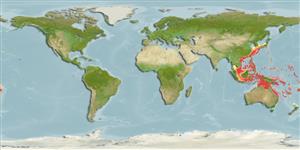Common names from other countries
Classification / Names / Names
Namen | Synonyme | Catalog of Fishes (gen., sp.) | ITIS | CoL | WoRMS
Environment: milieu / climate zone / depth range / distribution range
Ökologie
; tiefenbereich 15 - 150 m (Ref. 100565). Tropical
Western Pacific: Hong Kong, Philippines, and New Caledonia.
Length at first maturity / Size / Gewicht / Alter
Maturity: Lm ? range ? - ? cm Max length : 3.0 cm ShH Männchen/unbestimmt; (Ref. 821)
Shell translucent with yellow tips. Body creamy white with dark red spots.
Length based on occurrence record; to be replaced with better reference. Maximum depth from Ref. 100566. Commensal with Euplexaura curvata (Ref. 126204).
Life cycle and mating behavior
Geschlechtsreife | Fortpflanzung | Ablaichen | Eier | Fecundity | Larven
Members of the order Neotaenioglossa are mostly gonochoric and broadcast spawners. Life cycle: Embryos develop into planktonic trocophore larvae and later into juvenile veligers before becoming fully grown adults.
Springsteen, F.J. and F.M. Leobrera. 1986. (Ref. 821)
IUCN Rote Liste Status (Ref. 130435)
CITES Status (Ref. 108899)
Not Evaluated
Not Evaluated
Nutzung durch Menschen
| FishSource |
Tools
Internet Quellen
Estimates based on models
Preferred temperature
(Ref.
115969): 24.3 - 28.2, mean 26.6 (based on 93 cells).
Verwundbarkeit
Low vulnerability (10 of 100).
